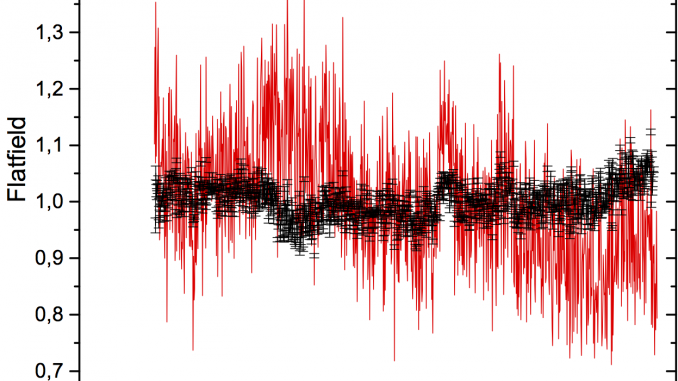
Dr. Albrecht Petzold found and experimenting with this particular issue on his instrument: it looks like the Dectris Mythen detector signal can be cleaned up considerably by applying a flatfield correction.
While flatfield corrections have been discussed before with regard to wire detectors, we usually don’t worry much about it for the Mythen detector on the slit-collimated Kratky instruments. We should have, though, since even for the Pilatus detectors a flatfield was found to be beneficial (I’m not sure I ever wrote that up).
Dectris supplies flatfields for their detectors for a variety of energies, but the flatfield changes over time (several months) and changes with adjustment of the detector parameters (in particular with the proximity of the energy threshold to the measured energy). There are also other effects such as incidence angle inefficiencies that cannot be predicted by Dectris, and therefore a flatfield is ideally collected in the final instrument configuration.
On his instrument, a nearly identical SAXSess II like ours, Albrecht tried using the fluorescence signal from our iron foil to measure the flatfield. If this works, it would be useful since the signal strength of the iron foil is quite good, necessitating mere hours for a flatfield measurement. However, iron fluorescence is of a slightly different energy than the Cu k$latex_\alpha$ energy we use for the measurements. Therefore, as a control measurement, the flat scattering of water was measured over a week-end to provide a second flatfield.

The corrections calculated from the measured signals (Figure 1) tell us that the deviations are significant (about +/- 5%), and that the two different methods do not provide the same flatfield. This means that if we correct for the flatfield, we should be able to reduce the uncertainties in our final measurement considerably. It also means that we can (unfortunately) not rely on the fluorescence of iron to deliver us our flatfield. The discrepancies between the two are somewhat surprising to me, and I don’t have a good explanation for them yet. I am not convinced they can be completely explained by the energy threshold effects, but maybe I’m wrong.
So next up, as soon as I’m back from holiday, I’ll get to measuring a flatfield on our own instrument. On that one, we can turn the detector 180 degrees as well, so we can verify the data to some degree (apparently this possibility has been removed by Anton Paar in their later version). Interesting times!

Leave a Reply